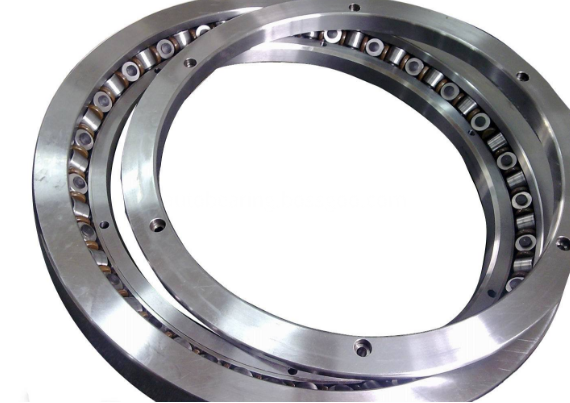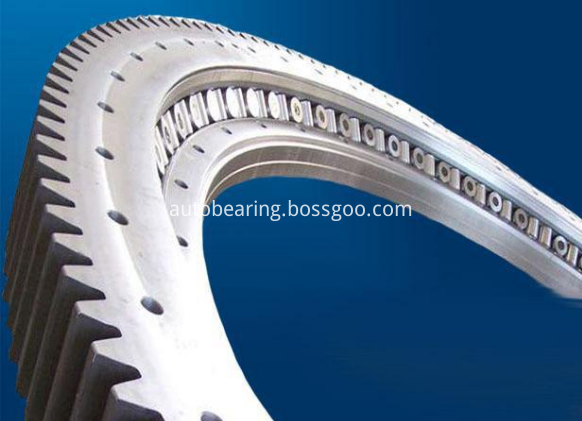Their rollers and the outer wheels are arranged in a right angle intersecting intersecting. They can bear the load from all directions at the same time (such as axial, thrust or momentum hormones, etc.). Because of the linear contact between the roller and the track surface, the possibility of the axis to bear the load and the elastic deformation is very small. This type of bearing is widely used in industrial robots, working machines and medical facilities. It needs high rigidity, high speed and high speed to ensure precise occasions.
In cross roller bearings, cylindrical rollers are perpendicular to each other through spacer retainers on the top, so 1 cross roller bearings can bear all loads of radial load, axial load and torque load. Ring size is the minimum limit of miniaturization, especially very thin type is small size close to the limit, and has high rigidity, so the most suitable for use in industrial robot joint or rotating parts, machining center machine rotary table, hand rotating parts, precision rotary table, medical machine, metering device, IC manufacturing equipment etc.
1. Excellent rotation accuracy
Crb Bearing,Cross Roller Slewing Bearing,Crb Turntable Slewing Bearing,Cross Roller Slewing Bearing Crb LUOYANG AUTO BEARING CO.,LTD , https://www.ballbearing.nl
According to the reporter's understanding, starting from last year, the relevant state departments have carried out many studies on the reduction of tariffs, but all of them have been settled because of the firm opposition of the Ministry of Agriculture.
The main reasons for opposition are: Natural rubber is an important strategic material of the country. Although domestic production can only meet one-third of consumption, it plays an important role in the country's strategic use of rubber. Due to the country's lack of investment in farms for many years, the current agricultural landscaping system still faces great difficulties, and the income and living standards of employees are still very low. The rubber tree planting has a long period of production. China is also planting rubber in areas that are not suitable for rubber planting. The cost is high and the industry is fragile. Once it is impacted and shrunk, recovery will be very difficult. The country currently attaches great importance to the issue of agriculture, rural areas and farmers. Therefore, it is necessary to strengthen the protection of tariffs.
Since July of this year, natural rubber has once again risen at high prices, breaking through 16,000 yuan/ton across the board, making domestic tires and other rubber products companies account for nearly 80% of the cost of materials. The call for tax cuts by downstream companies has once again increased.
Recently, the China Rubber Industry Association once again sent an appeal to the National Development and Reform Commission, the Ministry of Finance, the State Council's Tax Committee, and the Ministry of Commerce to request the reduction of 20% of natural rubber import duties to 10%. The reason is clear: due to restrictions on geographical and climatic conditions, the domestic natural rubber production is unlikely to have a large increase, and with the development of the tire industry, the imbalance in the problem will gradually expand, the situation is very grim, it is expected this year, natural rubber imports Will exceed 130 million tons. From the perspective of the development trend of the world rubber industry, in the future, the shortage of natural rubber resources will exist for a long period of time, and prices will remain at a certain high level. Therefore, lowering tariffs will not have a greater impact on the plastics companies. Looking at the practice of some countries that do not produce natural rubber or natural rubber shortages in foreign countries is to encourage domestic rubber companies to make full use of the development of natural rubber resources in foreign countries, and only symbolically collect tariffs. For example, South Korea's natural rubber import tariff is only 1%, Japan is a zero tariff.
It is understood that the domestic natural rubber direct production costs about 6,000 yuan / ton, the indirect cost is only about 8,000 yuan / ton, according to the last two years of the plastic price calculation, its profit has been quite high.
According to another survey, at present, the import channels of natural rubber for domestic tire companies are based on the import of processing trade with a tax rate of zero; the second is the import of plastic compound, the tax rate is 8%; the third is the use of border trade, and the tax rate is 10%; According to general trade imports, the tax rate is 20%.
In fact, the vast majority of domestic natural rubber imports in the past two years are processing trade plastics and composite rubber. The number of imports in the form of general trade is very small. The reason is very simple and the tariff is too high. The import volume of compound glue soared. According to customs statistics, in 2003, China imported 256,000 tons of compound rubber, an increase of 186.08% over the previous year; in 2004, imports were 335,000 tons, an increase of 31% over the previous year.
In the investigation, the reporter found that companies actually do not welcome compound glue. The first is that the country does not have a unified standard for compound glues. In addition, the quality of processing is uneven and the quality cannot be effectively guaranteed. The second is that the compound glue is unfavorable to the subsequent processing quality. From this point of view, natural rubber circulation companies import natural rubber into composite rubber in the bonded area and then import it. The processing cost incurred during this period is purely a waste of social resources. The ratio of compound glue and the requirements of natural rubber users Incomplete agreement also causes a certain amount of waste. However, despite the huge differences in tariffs and import costs, companies have to use compound glue, which is also the main reason for the abnormal increase in imports of compound glue. If the import tariff of natural rubber is reduced to 10%, most of the plastics companies will not choose composite rubber, and the composite rubber will lose its market. However, starting from July 20 this year, China has implemented the China-ASEAN free trade area agreement tariff rate for six countries including Brunei, Indonesia, Malaysia, Myanmar, Singapore, and Thailand, and the import tariff for compounding rubber has dropped to 5%. Such a policy is really difficult to understand.
In the process of understanding the reporter, from time to time someone asked: 20% of the natural rubber import tariffs, the country actually did not get much, tire companies did not get the benefits they deserved, plastic farmers did not benefit from it, then this part of the profits go? It seems that only the operators know.
The China Rubber Industry Association and tire companies all have a common view that 20% of tariff protection is backward and can only cause market chaos. One of its drawbacks is that it weakens the viability and competitiveness of the downstream enterprises; the other is that the overprotection of the protected persons does not allow them to carry out drastic reforms; the third drawback is that they do not conform to international practices and cause market confusion.
According to the China Rubber Industry Association, the relevant national authorities are aware of this problem, but there is still resistance to reducing taxes.

The inner structure of the Cross Roller Bearing is arranged in 90 degrees perpendicular to each other by the roller.
The roller is equipped with a spacer or isolation block between the rollers to prevent the rolling of the rollers from being examined each other. In addition, the phenomenon of roller contact or locking will not occur. At the same time, because the inner and outer ring is a segmented structure, the clearance can be adjusted, even if the preload is applied, high accuracy rotation motion can also be achieved.
2. Simplification of operation and installation
The outer ring or inner ring, which is divided into 2 parts, is fixed together after loading the roller and the holder, so the operation is very simple.
3. Bear large axial and radial load
The roller is arranged vertically through the spacer retainer on a 90 degree V groove rolling surface.
4. Greatly save the installation space
The size of the inner and outer ring cross Roller Bearing is miniature minimal, especially ultra-thin structure is small size close to the limit, and has high rigidity, so the most suitable for industrial robot joints or rotating parts, machining center of the rotary table, the robot rotating parts, precision rotary table, medical instrument IC, measuring equipment, manufacturing device widely used.
5. high speed ability
6. reducing shaft length and machining cost, thermal expansion leads to a limited change in geometric size.
7. the nylon separator is used, the moment of inertia is low, the starting torque is low, and the angle degree is easy to control.
8. optimization of pretightening force, large rigidity, high precision of guiding roller
9. carbon steel provides excellent impact resistance and surface abrasion resistance
10. simple but fully lubricated

Observing the perspective of the birthplace: the import tariff of natural rubber should not be lowered
There is a shortage of natural rubber resources in China, and two-thirds of them rely on imports each year. Before 2002, China's natural rubber import tariff was 25%, but in-quota tariffs were actually collected at 12%. Since 2002, China has unified its natural rubber import tariffs at 20%, nominally 5%, while actual implementation has increased by 8%. Since then, natural rubber import tariffs have caused widespread concern. Especially since the second half of 2002, due to the soaring prices of natural rubber, the cost of using plastics companies has risen dramatically, and natural rubber import tariffs have also become the focus of disagreement between upstream and downstream industries. The tariffs around 20% are high and low, and should not be lowered. The voice of controversy is increasing.